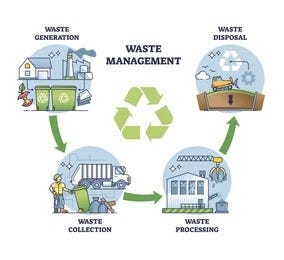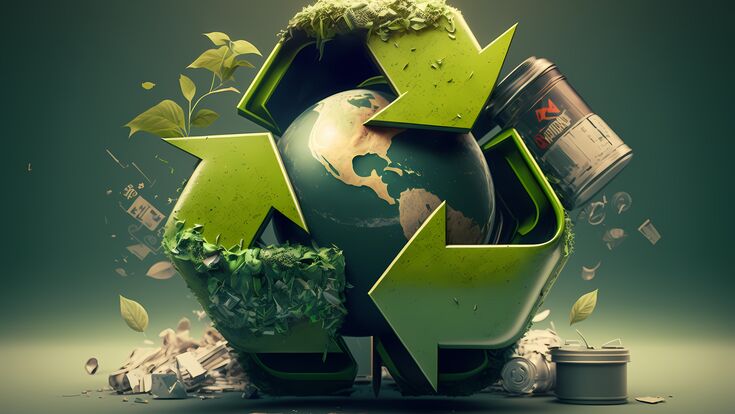How Recycling Lives Services Make a Distinction in Sustainable Waste Administration
How Recycling Lives Services Make a Distinction in Sustainable Waste Administration
Blog Article
Discovering Various Types of Waste in Modern Waste Management Equipment
The contemporary landscape of waste monitoring includes navigating a complicated range of waste kinds, each calling for specialized handling and disposal approaches to reduce environmental impacts. Local strong waste, hazardous waste, electronic waste, and organic waste each existing distinctive difficulties and opportunities for resource healing.
Metropolitan Solid Waste
Municipal solid waste, usually referred to as household trash or trash, incorporates a selection of thrown out products generated by household, industrial, and institutional resources within a community. This waste stream usually consists of items such as packaging, food scraps, yard trimmings, paper, plastics, fabrics, and disposed of family goods. The monitoring of community strong waste is an important element of city planning and public wellness, necessitating reliable collection, transport, and disposal systems.
Efficient waste management systems are developed to lessen ecological influence while optimizing source recovery. Composting organic waste, such as food scraps and backyard trimmings, not only decreases garbage dump usage however additionally produces important soil amendments.
Communities must likewise attend to the financial and logistical difficulties connected with waste monitoring. Implementing pay-as-you-throw systems, enhancing public awareness, and investing in modern technology can considerably improve waste diversion rates. By incorporating these techniques, communities can cultivate lasting neighborhoods, decrease greenhouse gas emissions, and preserve all-natural sources.
Hazardous Waste

Reliable harmful waste monitoring involves a number of crucial actions: recognition, disposal, treatment, and segregation. Recognition requires the classification of waste based upon its unsafe homes. Partition ensures that hazardous materials are kept independently from non-hazardous waste to stop cross-contamination. Treatment techniques, such as chemical neutralization, incineration, and stablizing, are employed to decrease the poisoning, volume, or mobility of the waste. Disposal choices, consisting of safe and secure landfills and underground storage space, are picked to make certain lasting control.
Regulatory structures, such as the Source Conservation and Healing Act (RCRA) in the United States, provide standards and criteria for contaminated materials administration. Adherence to these regulations, paired with innovations in waste therapy innovations, is important in mitigating the threats connected with contaminated materials.
Digital Waste
Electronic waste, commonly described as e-waste, represents a swiftly expanding challenge in waste monitoring systems internationally. This kind of waste encompasses disposed of electronic gadgets and equipment such as smart devices, computers, tvs, and other digital home appliances. The quick speed of technical improvement, coupled with lowering product life-spans and consumer demand for the most recent gadgets, has actually significantly raised the volume of e-waste created each year.
E-waste is especially bothersome because of its intricate composition, commonly containing harmful materials like lead, mercury, and cadmium, which present substantial environmental and health and wellness threats otherwise correctly handled. Alternatively, e-waste also includes useful products such as gold, copper, and silver, which can be recovered and recycled. The double nature of e-waste-- both unsafe and valuable-- requires specific handling, reusing, and disposal procedures.
Effective e-waste management involves strict regulative structures, robust collection systems, and advanced reusing innovations. Public awareness and participation are vital, as inappropriate disposal practices, such as prohibited dumping and casual recycling, worsen ecological contamination and carcinogen. Boosting e-waste administration methods is important for mitigating ecological impact and recovering valuable sources in an increasingly digital globe.

Organic Waste
Organic waste, consisting of cooking area scraps, lawn trimmings, and agricultural residues, represents a substantial part of the global waste stream. This kind of waste is biodegradable, indicating it can be broken down by microbes into easier organic compounds. Regardless of its capacity for all-natural decomposition, incorrect management of organic waste can bring about unfavorable ecological influences, including the discharge of greenhouse gases such as methane, which add visit this website to environment change.
Effective administration of natural waste is important for decreasing these environmental effects (recycling lives services). Composting is a commonly taken on method, transforming organic waste right into nutrient-rich garden compost that can enhance soil health and wellness and farming performance. go Additionally, anaerobic digestion is an emerging technology that transforms organic waste into biogas, an eco-friendly energy resource, and digestate, which can be made use of as fertilizer
Municipalities and waste management entities should implement robust natural waste collection and therapy programs to optimize the advantages of these procedures. Public education and learning projects can additionally play a pivotal role in encouraging homes and companies to separate organic waste from other sorts of waste. By prioritizing the management of organic waste, cultures can lower land fill usage, reduced greenhouse gas exhausts, and develop useful by-products for agricultural use.

Innovative Waste Management
In the realm of waste monitoring, cutting-edge methodologies are transforming how societies handle their refuse, going for sustainability and effectiveness. These improvements incorporate a series of innovations and techniques that boost reusing rates, minimize garbage dump reliance, and reduced ecological influence. One famous technology is the implementation of smart waste containers outfitted with sensing units that check fill degrees and enhance collection paths. This not only decreases fuel consumption but additionally decreases greenhouse gas exhausts.
One more noteworthy development is the fostering of waste-to-energy (WtE) innovations. By converting non-recyclable waste right into functional energy via processes such as incineration and anaerobic food digestion, WtE minimizes garbage dump burden and gives a sustainable energy resource. Furthermore, advancements in chemical reusing permit the failure of complicated plastics into their initial monomers, allowing the creation of brand-new, premium plastic items.
Furthermore, the round economic climate version is acquiring grip, highlighting the layout of products and systems that prioritize reusability and source efficiency. This all natural method motivates industries to lessen waste generation from the outset. With these cutting-edge techniques, modern waste monitoring systems are not only attending to the prompt challenges of waste disposal yet also paving the method additional resources for an extra lasting future.
Conclusion
An extensive understanding of local strong waste, hazardous waste, electronic waste, and organic waste, combined with the implementation of cutting-edge waste administration options, is critical for reducing environmental influences. Integrating modern technologies such as clever waste containers and waste-to-energy systems can enhance effectiveness and sustainability. Efficient waste monitoring approaches not just foster source recuperation yet also advertise public awareness and participation, ultimately adding to the development of a circular economy.
The contemporary landscape of waste management involves navigating an intricate selection of waste kinds, each calling for specialized handling and disposal approaches to alleviate ecological effects. Community solid waste, hazardous waste, electronic waste, and natural waste each existing distinctive difficulties and chances for resource recovery.Digital waste, frequently referred to as e-waste, stands for a rapidly growing obstacle in waste monitoring systems internationally. With these ingenious techniques, modern waste management systems are not just resolving the instant challenges of waste disposal yet additionally paving the way for an extra sustainable future.
An extensive understanding of municipal solid waste, dangerous waste, digital waste, and natural waste, coupled with the execution of ingenious waste administration services, is vital for reducing ecological effects. (recycling lives services)
Report this page